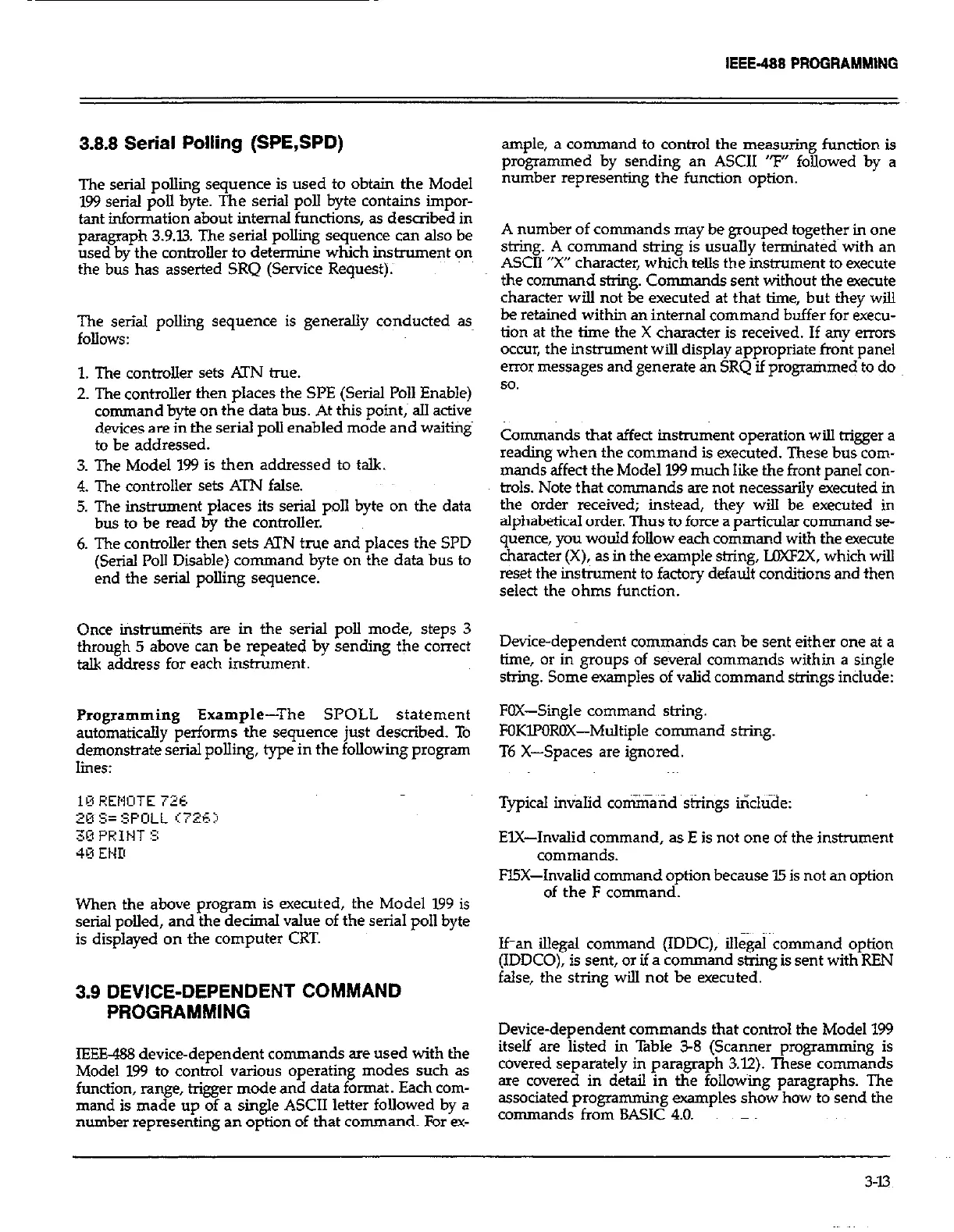IEEE-488 PROGRAMMING
3.8.8 Serial Polling (SPE,SPD)
The serial poIIing sequence is used to obtain the Model
199 serial poll byte. The serial poIl byte contains impor-
tant information about internal functions, as described in
paragraph 3.9.13. The serial polIing sequence can also be
used by the controller to determine which instrument on
the bus has asserted SRQ (Service Request):
The serial polling sequence is generally conducted asp
follows:
1. The contrder sets P;IN true.
2. The controller then places the SPE (Serial Poll Enable)
command byte on the data bus. At this point; all active
devices are in the serial poll enabled mode and waiting~
to be addressed.
3. The Model 199 is then addressed to talk.
4. The controller sets ATN fake.
5. The instrument places its serial poll byte on the data
bus to be read by the controller.
6. The controlher then sets ATN true and places the SPD
(Serial Poll Disable) command byte on the data bus to
end the serial polling sequence.
Once instrumtiiits are in the serial poll mode, steps 3
through 5 above can be repeated by sending the correct
talk address for each instrument.
Programming Example-The SI’OLL statement
automatically performs the sequence just described. TO
demonstrate serial polling, type in the following program
lines:
When the above program is executed, the Model 199 is
serial polled, and the decimal value of the serial poll byte
is displayed on the computer CRT.
3.9 DEVICE-DEPENDENT COMMAND
PROGRAMMING
IEEE-488 device-dependent commands are used with the
Model 199 to control various operating modes such as
function, range, trigger mode and data format. Each com-
mand is made up of a single ASCII letter followed by a
number representing an option of that command. For ex-
ample, a command to control the measuring function is
programmed by sending an ASCII “F” followed by a
number representing the function option.
A number of commands may be grouped together in one
string. A command string is usuaIly terminated with an
ASCII “X” character, which tells the instrument to execute
the command stxing. Commands sent without the execute
character will not be executed at that time, but they will
be retained within an internal command buffer for execu-
tion at the time the X character is received. If any errors
occur, the instrument wilI display appropriate front panel
error messages and generate an SRQ if prograkned to do
so.
Commands that affect instrument operation will trigger a
reading when the command is executed. These bus com-
mands affect the Model 199 much Iike the front pane1 con-
trols. Note that commands are not necessarily executed in
the order received; instead, they will be executed in
alphabetical order. Thus to force a particular command se-
quence, you would follow each command with the execute
character (X),~ as in the example sting, L.OXF2X, which will
reset the instrument to factory default conditions and then
select the ohms function.
Device-dependent commands can be sent either one at a
time, or in groups of several commands within a single
string. Some examples of valid command strings indude:
FOX-Single command string.
FOKlPOROX-Multiple command string.
T6 X-Spaces are ignored.
Typical invalid command stings iriclude:
ED&-Invalid command, as E is not one of the instrument
commands.
F15X-Invalid command option because 15 is not an option
of the F command.
If-an illegal command (IDDC), illegal command option
(IDDCO), is sent, or if a command string is sent with REN
false, the string will not be executed.
Device-dependent commands that control the Model 199
itself are listed in Table 3-8 (Scanner programming is
covered separately in paragraph 3.12). These commands
are covered in detail in the foIloWing paragraphs. The
associated programming examples show how to send the
commands from BASIC 4.0.
3-w
